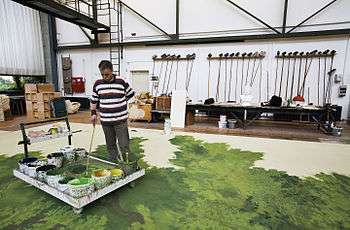Scenic painting

Theatrical scenic painting includes wide-ranging disciplines, encompassing virtually the entire scope of painting and craft techniques. An experienced scenic painter will have skills in landscape painting, figurative painting, trompe l'oeil, and faux finishing, be versatile in different media such as acrylic, oil, and tempera paint, and be an accomplished gilder, plasterer, and sculptor. The techniques and specialized knowledge of the scenic painter in replicating an image to a large scale are largely different from those of the traditional studio artist.. In addition, he or she is often expected to make the finished product fire-proof, and to work quickly within a tight budget.
Traditionally, scenic painters are drawn from the ranks of scenic designers, and in some cases designers paint their own works. Increasingly scenic painting is looked upon as a separate craft, and scenic painters are expected to subordinate their skills to those of the designer. A designer submits scaled paintings, maquettes or photographs, perhaps with original research, and sometimes accompanied by paint samples; the painter is expected to paint scenery to match.